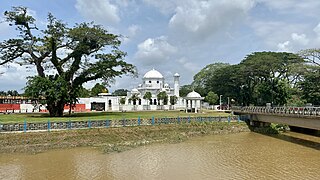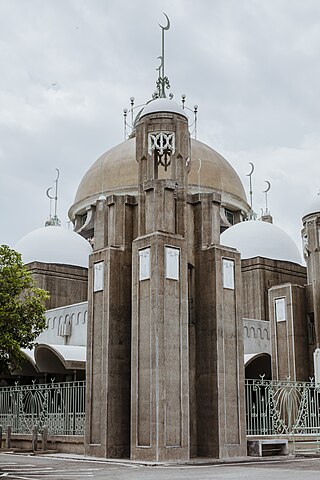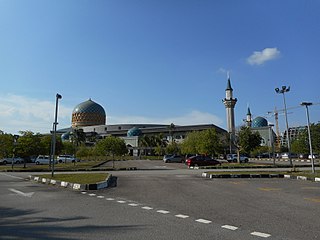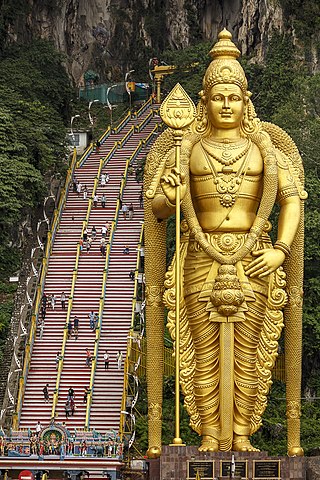
Bangsar is a residential suburb on the outskirts of Kuala Lumpur, lying about 4 kilometres (2.5 mi) south-west of the city centre. It is part of the Lembah Pantai parliamentary constituency. Bangsar is administered by Dewan Bandaraya Kuala Lumpur (DBKL), unlike other townships in the Klang Valley such as Petaling Jaya and Subang Jaya which have their municipal councils. Neighbourhood residents' associations and business councils play a part in communicating with the local authority, but they exercise no legal or administrative power. Malays make up most of the population at 61%, followed by the Chinese at 24%, Indians at 15%.

Pekan is a town in Pekan District, Pahang, Malaysia. It is also the royal capital of the state. Its name comes from a flower, the Bunga Pekan. Pekan is also the name of the district the town is situated in, and a parliamentary constituency in its own right. It is the home of the state's royal family headed by Sultan Abdullah of Pahang. It is also the hometown of the second Prime Minister of Malaysia, Tun Abdul Razak Hussein.

The National Mosque of Malaysia is a mosque in Kuala Lumpur, Malaysia. It has a capacity for 15,000 people and is situated among 13 acres (53,000 m2) of gardens. Its key features are a 73-metre-high (240 ft) minaret and a 16-pointed star concrete main roof. The umbrella, synonymous with the tropics, is featured conspicuously – the main roof is reminiscent of an open umbrella, the minaret's cap a folded one. The folded plates of the concrete main roof are a creative solution to achieving the larger spans required in the main gathering hall. Reflecting pools and fountains are spread throughout the compound. Completed in 1965, the mosque is a bold and modern approach in reinforced concrete, symbolic of the aspirations of a then newly independent nation.

Sultan Sulaiman Royal Mosque is Selangor's royal mosque, which is located in Klang, Selangor, Malaysia. It was constructed by the British in the early 1932 and was officially opened in 1933 by the late Almarhum Sultan Sir Alaeddin Sulaiman Shah.

Sultan Abu Bakar State Mosque is the state mosque of Johor, Malaysia. Located along Jalan Skudai, Johor Bahru, the mosque was constructed between 1892 and 1900, under the direction of Sultan Abu Bakar.

Al-Azim Mosque is the state mosque of Malacca. It is located next to the Malacca General Hospital, the Malacca Al-Quran Museum and the State Heroes Mausoleum and was constructed to replace the former state mosque at Tranquerah Mosque and officially opened on 13 July 1990 by the ninth Yang di-Pertuan Agong, Sultan Azlan Shah of Perak.

The Ubudiah Mosque is a small mosque located in the royal town of Kuala Kangsar, Perak, Malaysia.

The Sultan Ahmad Shah Mosque is Pahang's state mosque. It is located in Kuantan, Pahang, Malaysia.

Mutiara Rini is a housing area and suburb in Skudai, Johor, Malaysia. It is developed by Mutiara Rini Sdn Bhd, a subsidiary of the military-linked Boustead Group.

The Sultan Abdul Samad Mosque or KLIA Mosque is a mosque near Kuala Lumpur International Airport (KLIA) at Sepang District, Selangor, Malaysia. The mosque was originally named as KLIA Mosque and was officially named after Almarhum Sultan Sir Abdul Samad of Selangor. It is also used as an international mosque for tourist who arrived and depart from/to KLIA. It is also a public mosque for Muslims from Salak Tinggi and KLIA Town Centre.

This article lists important figures and events in Malaysian public affairs during the year 1965, together with births and deaths of significant Malaysians. Singapore left the Federation of Malaysia on 9 August.

This article lists important figures and events in Malaysian public affairs during the year 2006, together with births and deaths of notable Malaysians.

The Abu Bakar Royal Mosque is Pahang's royal mosque which is located in Pekan, Pahang, Malaysia. It was officially opened in 1976 by Sultan Ahmad Shah of Pahang replacing the nearby Abdullah Mosque or Old Royal Mosque.
The architecture of Kuala Lumpur is a blend of old colonial influences, Asian traditions, Malay Islamic inspirations, modern and post modern mix. Being a relatively young city, most of Kuala Lumpur's colonial buildings were built toward the end of 19th and early 20th century. These buildings have Mughal, Tudor, Neo-Gothic or Grecian-Spanish style or architecture. Most of the styling have been modified to cater to use local resources and the acclimatized to the local climate, which is hot and humid all year around.

Batu Caves is a mukim and town in Gombak District, Selangor, Malaysia. Named after the limestone caves and Hindu shrine Batu Caves, the town is experiencing an increase in residences due to a housing boom in the center of the city.
Al Akram Mosque is a mosque in Kampung Datuk Keramat, Kuala Lumpur, Malaysia.
The Saidina Umar Al Khattab Mosque (MSUAK) is a prominent mosque in Bukit Damansara, Kuala Lumpur, Malaysia.

Jamek Mosque, officially Sultan Abdul Samad Jamek Mosque is one of the oldest mosques in Kuala Lumpur, Malaysia. It is located at the confluence of the Klang and Gombak rivers and may be accessed via Jalan Tun Perak. The mosque was designed by British architect and soldier Arthur Benison Hubback, and built in 1909. It was the principal mosque of Kuala Lumpur until the construction of the national mosque Masjid Negara in 1965.
Kampung Padang Balang or Padang Balang is the oldest surviving traditional village in Kuala Lumpur, Malaysia. It is circumferenced by Gombak Road, Jalan Kampung Bandar Dalam, Duta–Ulu Klang Expressway (DUKE), Kuala Lumpur Middle Ring Road 2 and Gombak River.


















